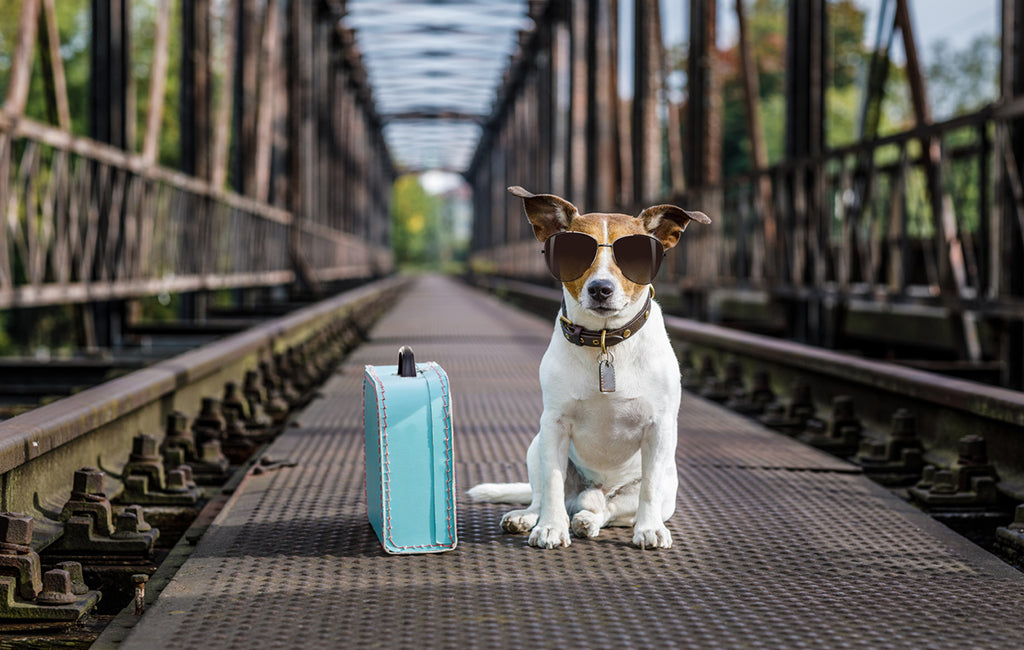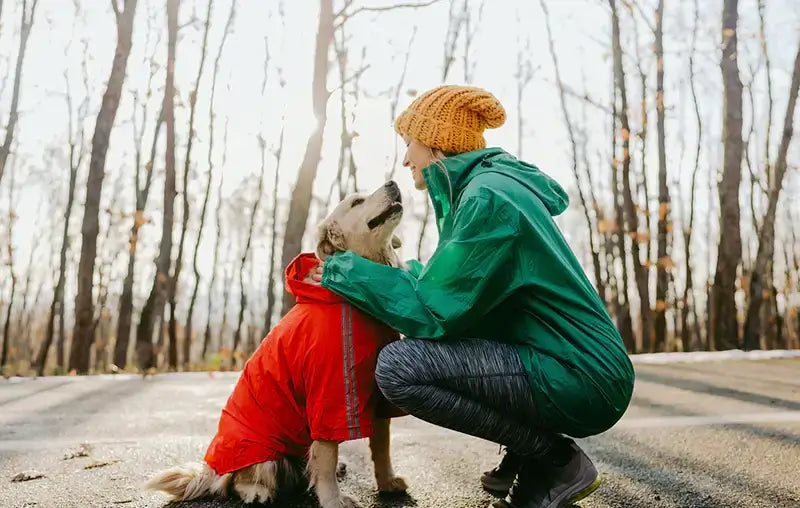
Whether you’re avoiding a costly pet sitting fee or planning to bring your furry friend on an adventure of a lifetime, the ins and outs of traveling with your dog should be first on your packing list.
There’s a lot to consider as a pet owner when traveling with dogs — travel policies, documentation, accommodations, and, most importantly, your dog’s comfort, health and safety. And let’s face it, that can be stressful — for both you and your pooch.
Luckily, with the right knowledge under your belt and a bit of extra planning, you and your wonderful companion will be ready to set off on a stress-free holiday.
Planes, Trains and Automobiles: A How-To Guide
Your chosen mode of transportation will inevitably play a large role in your travel plans — there will be far more pet requirements when traveling by plane than when driving in the comfort of your car.
Whatever transportation you choose, make sure your dog feels safe and comfortable during the entire journey.
Airline Travel
Traveling by plane is perhaps one of the more complicated modes of travel when traveling with a pet.
Before you begin to think about how you’ll get to your destination and where you’ll be staying, you need to gather the correct documentation — especially if you plan to cross a border or two.
When traveling with dogs, make a physical and electronic backup copy of your documents in case you lose the originals:
- Pet identification and records – Provide airline officials with the proper pet passport. This includes identification paperwork, such as a photo of the pet and a record of his or her vaccinations.
- GSA waiver – If you’re planning to travel by plane, you’ll need a GSA Waiver to ensure your animal makes it to your destination. Additionally, each airline has different requirements and restrictions regarding pet travel policy, which will be present in each waiver.
- USDA certification – Depending on your destination, some countries require veterinarian examinations to be done by a USDA-certified veterinarian. Other times, a country may not require this type of certification, but the airline does.
- Paperwork required by the destination country – Some countries require specific types of pet documentation that other countries do not. When preparing your paperwork, do your research and check with your destination’s embassy or consulate to be aware of all required documentation.
Some countries require a pet quarantine period following the arrival of your dog. This can last anywhere from two weeks to six months. Check with the International Animal Export Regulations to view specific requirements for each country. Additionally, some countries also require pets to have an ISO microchip before entering their border.
When planning to take your dog on a plane, contact the airline directly to make sure you understand its pet travel policies — there will most often be an additional pet fee as well.
You’ll also need to consider whether you’ll check or carry on your pet:
- Check baggage – Checked pets will travel in the cargo zone under the plane. When you arrive at the airport, you’ll go to your airline’s check-in counter and check your dog as you would with luggage. Be sure to have all documentation on hand, including your identification and ticket information.
- Carry-on – If you plan to travel with your dog in the cabin, you’ll need to check with the airline’s travel policies to acquire the correct size pet carrier. Most often, dogs cannot sit freely in the cabin unless they’re a certified service animal.
- If your dog is a service animal, it can travel in the cabin for free. To qualify as a service animal, your dog must be certified to assist you with a physical or psychiatric disability, and you must be able to prove this to the airline with proper documentation. Unfortunately, Emotional Support Animals no longer qualify for the same benefits.
Train Travel
Taking a cross-country trip by train is a great way to see the country up close and personal — but how does one do it with a dog in tow?
Typically, if you’re traveling with a larger dog, a train may not be your best option. Very few national train companies actually allow dogs in their cabins. Luckily, Amtrak recently introduced a small cat and dog program to transport pets (larger dogs are only allowed on the rails if they are medically certified service animals).
However, small dog owners can rejoice! Your little Pomeranian or dachshund can accompany you on the Amtrak caravan, as long as you meet the following qualifications:
- The ride is less than seven hours long
- Your dog is at least eight weeks old
- Your dog is small enough to fit in a carrier and be stowed under the seat
- Your dog (and its carrier) weigh no more than 20 pounds
When planning your convoy, make your reservations as soon as possible — Amtrak only allows five dogs on each train. Most often, the train company will tack on an additional pet fee to your ticket price when traveling with a dog, too.
Unfortunately for tiny Fido, dogs can only ride coach, meaning you will not be able to book tickets for first-class accommodations or sleeping cars.
In regards to paperwork, railroad travel services like Amtrak will most likely require a signed pet agreement upon check-in. You’ll most likely need to provide your dog’s most recent vaccination records at this time as well.
Car Travel
Car travel allows you to take on the open road without the nitty-gritty of airline and railroad pet policies — and it’s arguably the easiest way to travel hassle-free. Using your own car also provides a familiar space where your pooch can feel safe during long travel days.
Whether you’re road tripping to an out-of-state campsite or traveling across the border for a Canadian vacation, you’ll need a copy (or two) of:
- Your pet’s identification – Check that your pet’s identification tags are up to date and readable. If your dog is not microchipped, consider making an appointment with your vet to implant a tracking device to ensure you’ll find your dog more easily if they scurry out of sight.
- Your pet’s health certificate – Make an appointment with your dog’s veterinarian to get a signed certificate of your pet’s medical history and vaccination records that is no older than 10 days at the time of travel (most destinations require a rabies vaccination).
When packing your dog into your trunk or back seat, make sure they’re properly taken care of with:
- Comfortable seating such as a blanket or bed
- Ventilation, whether it’s from open windows or AC
- Water, food and treats, but stay away from feeding them large amounts of snacks during the ride to avoid car sickness
- Frequent stops for exercise and potty breaks
Where to Stay When Traveling With Your Dog
There’s certainly a large amount of dog-friendly hotels and motels dotted alongside interstate highways. Do a bit of pre-departure planning and research potential accommodations that’ll happily take in you and your dog for a night or two, depending on breed and size restrictions.
When staying at a hotel with a dog, there are a few etiquette guidelines:
- Be respectful to other guests and avoid leaving your dog alone in the hotel room if they’re known to bark during separation.
- If your dog can handle being on its own, always dog-proof the hotel to avoid any property damage or harm your doggo could incur.
- Pick up after your pet, and never leave a mess behind — it may deter the hotel from hosting other furry guests.
Your Dog’s Comfort and Safety
Last, but certainly not least, your dog’s comfort, health and safety are perhaps the most important things to consider when traveling with your dog.
You know your dog better than the rest — you know their love needs, their favorite treats and what makes them shake with fright or wag with joy. Consider these needs seriously when preparing your dog for a trip:
- Airplane – Let’s face it, turbulence isn’t the only unpleasant thing about flying. There are long lines, hurried scrambles through security checkpoints and strange noises and sensations once onboard the flight — that first lift can be quite overwhelming for our canine companions. When flying:
- Inform airport and airplane employees that you’re flying with a dog, especially if they’re in the cargo hold. You are your dog’s strongest advocate — if the plane is delayed or you have special concerns, inform the staff ASAP so they can check on your dog whenever possible.
- Make sure your dog’s crate or carrier has the proper identification in the case of a lost luggage situation.
- Give your dog enough treats and water to withstand the trip, if possible.
- Train – Keep your pet with you at all times. Because dogs are typically not allowed in food carts, bring along a snack for you andyour dog. If your dog is especially hyper, bring along a few chew toys or bones to entertain them during the long journey, too. And as always, don’t forget an extra water bottle to hydrate your pup.
- Car – If your dog is unfamiliar with driving, prep them with a few short-distance rides before the trip to help get them acquainted with life on the road. A familiar toy or blanket may help your nervous dog as well. As always, bring enough food and snacks to last the trip (and beyond), as well as any medication your dog may need.
During the journey, there are a few tricks to keep your dog calm and happy:
- Give them a chew toy, bone or blanket to entertain or distract them
- Give them lots of affection and reassurance throughout the trip
- Keep their routine as normal as possible — if they eat dinner every day at 5 p.m., stick to the schedule
- Give your dog calming supplements, such as CBD — especially if you’re traveling with an elderly canine or one that’s quickly overwhelmed
Understanding CBD: Your Dog’s Best Friend
You have your trusty travel companion at your side, shouldn’t your dog have the same?
CBD — which stands for cannabidiol — is derived from the hemp plant, a cousin to the marijuana plant — and it’s actually incredibly helpful for dogs, especially during travel.
Unlike marijuana, CBD contains no detectable THC so you won’t have to worry about your dog getting “high.”
Instead, CBD supports the well-being and vitality of your pup.
Dog CBD oil can help ease your pet’s stress levels and promote a sense of relaxation. This is especially helpful given that travel can cause dogs to feel a bit overwhelmed. Additionally, CBD may also support joint flexibility and mobility, which helps your pup when they’re confined in a tiny crate or a small backseat for multiple hours.
At the end of the day, CBD promotes relaxation and comfort, two sensations that make traveling that much easier.
Travel With Your Dog and Zebra CBD
Well, now you know how to travel with a dog. When planning a trip with your furry friend by your side, it’s incredibly important to prepare beforehand. You’ll need proper identification, medical records and any other comfort items that can help your dog stay calm, cool and collected.
Make one of those items Zebra CBD.
Here, we have a variety of CBD products formulated specifically for your canine’s well-being, health and vitality — both on and off the ground. Each of our CBD products is made from organically grown American hemp extract that is tested by two accredited third-party labs, so you can rest assured that your pup is getting high-quality ingredients.
Choose from CBD Stress & Calming Chews, CBD Joint & Hip Chews, and CBD oil. We also have a CBD Canine Balm to ease your dog’s joint discomfort after a long day of travel.
Now that you’ve read this article, it’s paramount that you take preventative measures and over prepare prior to traveling with your dog. You’ll need to do research on your travel destination and method of transport, curate the proper documentation and carry the right tools and treats to support your dog’s well-being.
For the latter, there’s us.
Source:
Centers for Disease Control and Prevention. Traveling with Pets. https://www.cdc.gov/importation/traveling-with-pets.html
U.S Department of State. Pets and International Travel. https://www.state.gov/pets-and-international-travel/
ASPCA. Travel Safety Tips for Pets. https://www.aspca.org/pet-care/general-pet-care/travel-safety-tips
Pet Travel. Pet Travel by Train. https://www.pettravel.com/pet-travel-train.cfm










